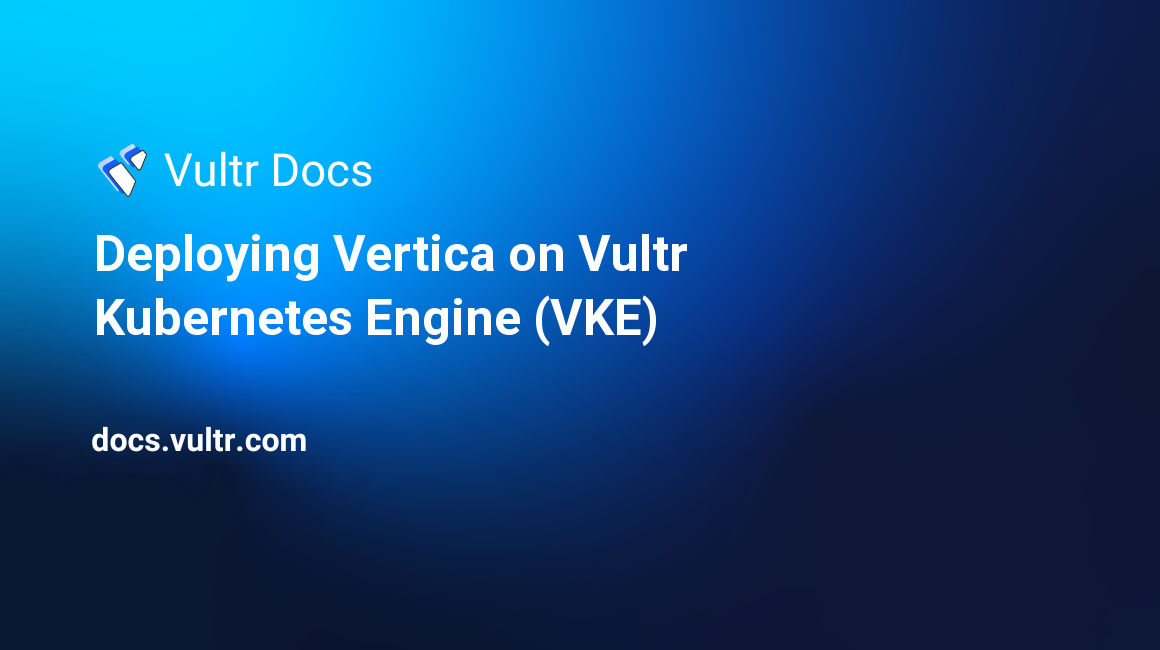Deploying Vertica on Vultr Kubernetes Engine (VKE)

About Vertica
Vertica is an industry-leading analytics platform providing fast, flexible, extensible, and SQL-compatible analytics on data lakes and data warehouses. Vertica offers a free-to-try Community Edition (CE) that supports up to 3 nodes serving a total of 1 terabyte of data. Vertica CE is installed in this example and can be upgraded by applying a license key. Learn more about Vertica.
Vertica's architecture separates compute and storage allows cost-effective, scalable, secure and performant operation on cloud and containerized platforms like Kubernetes. Vertica provides comprehensive open-source tooling to enable deployment and management on Kuberenetes, which we will demonstrate in this exercise.
Deploying Vertica on VKE
To demonstrate the flexibility and compatibility of Vertica on Kubernetes and S3 object storage, this document describes how to deploy Vertica Community Edition (CE) on Vultr, a cloud platform that provides S3 object storage and Kubernetes infrastructure that meet standards but are not officially supported.
Prerequisities for Vertica deployment:
- Configure a Vertica client: vsql CLI, ODBC/JDBC drivers, and others are available.
- Set up a Vultr account.
- Create an object store with an S3 bucket under Objects and obtain the access and secret keys as well as bucket endpoint and S3 path.
- Create a Kubernetes cluster (minimum 3 Cloud Compute nodes with 2 CPU / 4 GB RAM each) and download the cluster YAML configuration.
- Install kubectl and helm locally to manage the Kubernetes cluster. Ensure that kubectl uses the VKE cluster YAML configuration file.
The deployment largely follows the Vertica documentation. Please refer to the documentation for all possible options. The following steps will create a minimally configured Vertica cluster.
Install cert-manager:
$ kubectl apply -f https://github.com/jetstack/cert-manager/releases/download/v1.5.3/cert-manager.yamlVerify cert-manager is running:
$ kubectl get pods --namespace cert-manager
NAME READY STATUS RESTARTS AGE
cert-manager-7dd5854bb4-skks7 1/1 Running 5 12d
cert-manager-cainjector-64c949654c-9nm2z 1/1 Running 5 12d
cert-manager-webhook-6bdffc7c9d-b7r2p 1/1 Running 5 12dConfigure the Vertica helm chart repository:
$ helm repo add vertica-charts https://vertica.github.io/chartsUpdate the repository to ensure you have the latest version:
$ helm repo updateInstall the VerticaDB operator:
$ helm install vdb-op vertica-charts/verticadb-operatorCreate a secret storing your S3 keys:
$ kubectl create secret generic s3-creds --from-literal=accesskey=yourAccesskey --from-literal=secretkey=yourSecretkeyCreate a secret storing your dbadmin (superuser) password:
$ kubectl create secret generic su-passwd --from-literal=password=yourPasswordCreate a YAML file "vertica.yaml" to configure a Vertica database - you must edit path and endpoint to match your environment:
apiVersion: vertica.com/v1beta1
kind: VerticaDB
metadata:
name: vertica-demo
spec:
initPolicy: Create
superuserPasswordSecret: su-passwd
communal:
path: s3://bucket/path
endpoint: https://ewr1.vultrobjects.com
credentialSecret: s3-creds
local:
requestSize: 64Gi
subclusters:
- name: defaultsubcluster
size: 3
serviceType: LoadBalancer
nodePort: 32001Apply the YAML file:
$ kubectl create -f vertica.yamlCheck service status:
$ kubectl get svcWhen the service is up and the external IP and port are available, you will be able to connect as dbadmin with your Vertica client:
$ kubectl get svc
NAME TYPE CLUSTER-IP EXTERNAL-IP PORT(S) AGE
kubernetes ClusterIP 10.96.0.1 <none> 443/TCP 25m
vertica-demo ClusterIP None <none> 22/TCP 18m
vertica-demo-defaultsubcluster LoadBalancer 10.96.39.25 x.y.z.w 5433:32001/TCP,5444:31390/TCP 18m
verticadb-operator-webhook-service ClusterIP 10.100.167.55 <none> 443/TCP 20m
$ vsql -h x.y.z.w -p 5433 -U dbadmin -w secret-password
Welcome to vsql, the Vertica Analytic Database interactive terminal.
Type: \h or \? for help with vsql commands
\g or terminate with semicolon to execute query
\q to quit
dbadmin=> select * from nodes;
node_name | node_id | node_state | is_primary | is_readonly | node_address | node_address_family | export_address | export_address_family | catalog_path | node_type | is_ephemeral | standing_in_for | subcluster_name | last_msg_from_node_at | node_down_since | build_info
-------------------+-------------------+------------+------------+-------------+---------------+---------------------+----------------+-----------------------+------------------------------------------------+-----------+--------------+-----------------+-------------------+-------------------------------+-----------------+----------------------------------------------------
v_vertdb_node0003 | 45035996273704984 | UP | t | f | 10.244.66.4 | ipv4 | 10.244.66.4 | ipv4 | /data/vertdb/v_vertdb_node0003_catalog/Catalog | PERMANENT | f | | defaultsubcluster | 2022-02-23 23:57:25.005626+00 | | v11.1.0-0-669fd97287b9c05ae8b69656c04c16cffa268024
v_vertdb_node0001 | 45035996273842972 | UP | t | f | 10.244.35.198 | ipv4 | 10.244.35.198 | ipv4 | /data/vertdb/v_vertdb_node0001_catalog/Catalog | PERMANENT | f | | defaultsubcluster | 2022-02-24 00:00:55.02184+00 | | v11.1.0-0-669fd97287b9c05ae8b69656c04c16cffa268024
v_vertdb_node0002 | 45035996273842976 | UP | t | f | 10.244.156.68 | ipv4 | 10.244.156.68 | ipv4 | /data/vertdb/v_vertdb_node0002_catalog/Catalog | PERMANENT | f | | defaultsubcluster | 2022-02-23 22:57:57.528649+00 | | v11.1.0-0-669fd97287b9c05ae8b69656c04c16cffa268024
(3 rows)